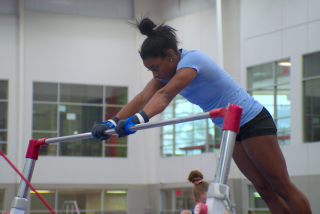The Long and Short of It
NEW YORK — While insisting that her poor long jump technique was not the reason she experienced back spasms at last year’s World Track and Field Championships, Marion Jones admits she has a lot to learn in the event.
“I don’t think the long jump contributed to the back problems that occurred in Seville [Spain],” Jones said on a conference call Wednesday. “But I realized that I have some problems with my technique. I don’t have the technique down pat, but I’m willing to learn.”
Jones won the 100 meters at the World Championships, then finished third in the long jump, ending her quest for four gold medals, and was forced to withdraw from the meet after pulling up with severe pain in her back during the semifinals of the 200.
“Overall, I was pleased with the long jump at Seville,” Jones said. “I fouled on my last attempt. I went for it. I’m proud of that.
“But I learned I need more competitions under my belt to gain confidence.”
Jones, with her tremendous sprint speed, has no problem coming down the long jump runway. It’s when she gets into the air and flies toward the pit that her difficulties occur.
To rectify those problems, Jones has been spending a lot of time working on the long jump since resuming training in November.
“I’m confident that when I have to produce, I will be ready,” she said. “I’ve been learning some new stuff.”
The long jump is one of five events in which Jones is planning to compete in at the Sydney Olympics. Should she win all five--the 100, 200, long jump, 400 relay and 1,600 relay--Jones would be the first track and field athlete to earn five gold medals at the same games.
Jones is puzzled why people think she is putting too much pressure on herself by saying she is going for an unprecedented five golds, especially after her downfall at Seville.
“My goal is to win every event I’m entered in,” she said. “It’s confusing that people make such a big deal of it. Is it too much to ask if I want to win every event I’m in?”
She might not realize her goal unless she becomes more consistent, technically sound and fluent in the long jump and avoids injury.
“At Seville, a lot of different things contributed to my injury,” Jones said. “A lot of people thought it was poor technique [in the long jump]. But I had spasms in my lower back. It could have been because the practice track was hard in Seville.”
A massage therapist and chiropractor worked on Jones’ back for two days in Seville, before she returned home to North Carolina for tests, including an MRI.
“They found that the weaknesses in my body were in my lower back, my glut and my abdominal area,” Jones said.
The back responded well to treatment, and Jones wasted no time in beginning her preparations for this season nearly three months ago. “I’m 100 percent physically,” she said.
Jones is skipping the indoor circuit, as usual, and won’t begin her outdoor season until April at the Mount San Antonio Relays at Walnut, Calif., where she will run a 400. That probably will be her only 400 of the year, except for running a leg on the Olympic 1,600-meter relay team.
Meanwhile, it was announced Wednesday that Jones signed with GMC Envoy, an Olympic sponsor and a national sponsor of the Golden Spike Tour and title sponsor of two meets.
One meet will be a Golden Spike event July 1 at Palo Alto, Calif., the other a United States vs. the World in a relay competition at a date and site yet to be determined.
Jones will be featured in a TV car advertisement that will break Saturday during NBC’s broadcast of the Golden Spike meet at Fairfax, Va. In addition, Jones’ agreement involves using her for print, web and direct mail advertising, as well as personal appearances.
More to Read
Go beyond the scoreboard
Get the latest on L.A.'s teams in the daily Sports Report newsletter.
You may occasionally receive promotional content from the Los Angeles Times.






